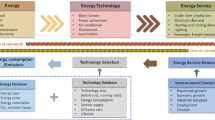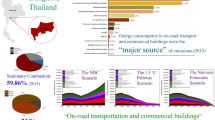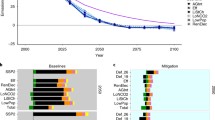Abstract
Emission of CO2, CH4, and NO x is among the main sources of greenhouse gases (GHGs) emitted through human activities such as fossil fuels combustion for power, heat and transportation, industrial processes, and land-use change. Low-carbon emission has become synonymous with GHG emission, which is often expressed in t CO2 eq. as derived from the major GHG. However, CO2 emission from fossil fuel constitutes just about 2/3 of GHGs. Low-carbon emission has received high publicity in recent years as a major reason for the potential mitigation of climate change. Achieving low GHG emission targets while decoupling the economic growth from high emissions, pollution, and resource use is desirable. This paper reviews the low-carbon emissions initiatives to develop resilient growth strategies to reduce GHG emissions in Asia and beyond. Four major initiatives, including the modelling of GHG emission and mitigation initiative; sustainable energy systems; sustainable waste management; and education and community outreach, are reviewed for mobilising the potential towards low-carbon emissions societies in Asia. Cooperation from major stakeholders, e.g. government, policy makers, financial institutions, private investors, industrial, commercial sector, residential, has been needed towards realising the goal.



Similar content being viewed by others
References
Alves JJ, Towler GP (2002) Analysis of refinery hydrogen distribution systems. Ind Eng Chem Res 41(23):5759–5769
Alwi SRW, Rozali NEM, Abdul-Manan Z, Klemeš JJ (2012) A process integration targeting method for hybrid power systems. Energy 44:6–10
Aziz EA, Alwi SRW, Lim JS, Abdul-Manan Z, Klemeš JJ (2016) An integrated Pinch Analysis framework for low CO2 emissions industrial site planning. J Clean Prod. doi:10.1016/j.jclepro.2016.07.175
Batan L, Quinn J, Willson B, Bradley T (2010) Net energy and greenhouse gas emission evaluation of biodiesel derived from microalgae. Environ Sci Technol 44:7975–7980
Boitier B (2012) CO2 emissions production-based accounting vs. consumption: Insights from the WIOD databases. In: WIOD Conference Paper. www.wiod.org/conferences/groningen/paper_Boitier.pdf. Accessed 7 Aug 2016
Bong CPC, Goh RKY, Lim JS, Ho WS, Lee CT, Hashim H, Mansor NNA, Ho CS, Ramli AR, Takeshi F (2016) Towards low carbon society in Iskandar Malaysia: implementation and feasibility of community organic waste composting. J Environ Manag. doi:10.1016/j.jenvman.2016.05.033
Cai YP, Huang GH, Tan Q, Yang ZF (2009) Planning of community-scale renewable energy management systems in a mixed stochastic and fuzzy environment. Renew Energy 34(7):1833–1847
Chan TK (2014) Green wealth in oil palm. Global Oils Fats Bus Mag 11(2):24–28
Demirbas MF (2011) Biofuels from algae for sustainable development. Appl Energy 88(10):3473–3480
El-Halwagi MM, Manousiouthakis V (1989) Synthesis of mass exchange networks. AIChE J 35:1233–1244
Gomi K, Shimada K, Matsuoka Y (2010) A low-carbon scenario creation method for a local-scale economy and its application in Kyoto city. Energy Policy 38(9):783–4796
Gomi K, Deshpande A, Kapshe M (2013) Aligning low carbon society scenario with city development goals in Bhopal, India. Global Environ Res 17(1):129–138
Haq G, Schwela D (2008) Foundation course on air quality management in Asia: urban air pollution in Asia. Stockholm Environment Institute, Stockholm
Hayashi Y, Simson JJ, Gomi K, Matsuoka Y (2012) Development of a method to design a low-carbon society in small community and its application to Putrajaya, Malaysia. Environ Res 67(6):213–224
Ho CS, Matsuoka Y, Simson J, Gomi K (2013) Low carbon urban development strategy in Malaysia–the case of Iskandar Malaysia development corridor. Habitat Int 37:43–51
Ho CS, Chau LW, The BT, Matsuoka Y, Gomi K (2016a) ‘Science to Action’ of the sustainable low carbon city-region: lessons learnt from Iskandar Malaysia. In: Nishioka S (ed) Enabling Asia to stabilise the climate. Springer, Singapore
Ho WS, Hashim H, Lim JS, Lee CT, Sam KC, Tan ST (2016b) Waste management pinch analysis (WAMPA): application of pinch analysis for greenhouse gas (GHG) emission reduction in municipal solid waste management. Appl Energy. doi:10.1016/j.apenergy.2016.01.044
Hoa NT, Gomi K, Matsuoka Y, Tu TT, Fujino J, Kainuma M, Shrestha RM (2010) Preliminary study on sustainable low-carbon development towards 2030 in Vietnam. 2050nies.go.jp/report/file/lcs_asia/Vietnam_Brochure_20100415.pdf. Accessed 28 July 2016
Jiang K, Zhuang X, Hu X (2009) Scenario analysis on low-carbon economy development of Jilin City. 2050.nies.go.jp/report/file/lcs_asialocal/Jilin.pdf. Accessed 28 July 2016
Jilani T, Gomi K, Matsuoka Y (2011) Low-carbon society development towards 2025 in Bangladesh. 2050.nies.go.jp/report/file/lcs_asia/Bangladesh_2012.pdf. Accessed 28 July 2016
Karanfil F, Li Y (2015) Electricity consumption and economic growth: exploring panel-specific differences. Energy Policy 82:264–277
Klemeš JJ, Varbanov PS, Kravanja Z (2013) Recent developments in process integration. Chem Eng Res Des 91(10):2037–2053
Klemeš JJ, Varbanov PS, Alwi SRW, Abdul-Manan Z (2014) Process integration and intensification: saving energy, water and resources. De Gruyter, Berlin
Lam HL, Varbanov P, Klemeš JJ (2010) Minimising carbon footprint of regional biomass supply chains. Resour Conserv Recycl 54(5):303–309
Linnhoff B, Flower JR (1978) Synthesis of heat exchanger networks. Part I. Systematic generation of energy optimal networks. AIChE J 24(4):633–642
Liu X, Klemeš JJ, Čuček L, Varbanov PS, Yang S, Qian Y (2015) Export-import of virtual carbon emissions and water flows embodied in international trade. Chem Eng Trans 45:571–576. doi:10.3303/CET1545096
Liu X, Klemeš JJ, Varbanov PS, Čuček L, Qian Y (2016) Virtual carbon and water flows embodied in international trade: a review on consumption-based analysis. J Clean Prod. doi:10.1016/j.jclepro.2016.03.129
Low Carbon Society Blueprint for Iskandar Malaysia 2025 (2012) Johor Bahru, Malaysia. 2050.nies.go.jp/cop/cop18/SPM_LCS%20Blueprint_Iskandar%20Malaysia.pdf. Accessed 27 July 2016
Marcotullio PJ, Sarzynski A, Albrecht J, Schulz N (2012) The geography of urban greenhouse gas emissions in Asia: a regional analysis. Global Environ Environ Change 22(4):944–958
Mi Z, Zhang Y, Guan D, Shan Y, Liu Z, Cong R, Yuan X, Wei Y (2016) Consumption-based emission accounting for Chinese cities. Appl Energy. doi:10.1016/j.apenergy.2016.06.094
Ngah I, Zulkifli AS (2014) Participatory approach in planning for low carbon and ecovillage: a case of Felda Taib Andak. In: 8th International Symposium of the Digital Earth (ISDE8) IOP Publishing IOP Conf. Series: Earth and Environmental Science 18. iopscience.iop.org/article/10.1088/1755-1315/18/1/012150/pdf. Accessed 28 July 2016
Nguyen TH, Gomi K, Matsuoka Y (2014) A scenario for sustainable low-carbon development in Vietnam towards 2030. Int Proc Chem Biol Environ Eng 61(1):1–5
Osawa R, Gomi K, Matsuoka Y (2014) Development of low carbon society scenarios considering energy and agriculture, forestry and landuse in Indonesia. Environ Res 70(5):201–209
Singhvi A, Shenoy UV (2002) Aggregate planning in supply chains by pinch analysis. Trans Inst Chem Eng Part A 80:597–605
Smith R (1995) Chemical process design. McGraw Hill Inc, New York
Tan RR, Foo DCY (2007) Pinch analysis approach to carbon-constrained energy sector planning. Energy 32:1422–1429
Tan S, Yang Y, Yan J, Lee C, Hashim H, Chen B (2016) A holistic low carbon city indicator framework for sustainable development. Appl Energy. doi:10.1016/j.apenergy.2016.03.041
The Global Carbon Atlas (2016). www.globalcarbonatlas.org/?q=en/emissions. Accessed 27 July 2016
The 11th Malaysian Plan 2016–2020 (2016) http://rmk11.epu.gov.my/pdf/11MP%20Summary%20BI.pdf. Accessed 10 Aug 2016
The Malaysia National Blue Ocean Strategy (NBOS) (2016). www.blueoceanstrategy.com/malaysia-nbos/. Accessed 10 Aug 2016
Ueda M (2013) Changing to a sustainable socio-economic system: A challenge for Kyoto as a historic city. Springer, London
UNU-INWEH (2013) The United Nations University, Institute for Water, Environment and Health. inweh.unu.edu/wp-content/uploads/2013/09/Waste-to-Wealth-Background-Paper.pdf. Accessed 9 Aug 2016
US Energy Information Administration (2016) International Energy Outlook 2016. www.eia.gov/forecasts/ieo/pdf/0484(2016).pdf. Accessed 17 Aug 2016
Wang YP, Smith R (1994) Wastewater minimization. Chem Eng Sci 49(7):981–1006
Wilson DC (2015) Global Waste Management Outlook (GWMO). UNEP DTIE International Environmental Technology Centre, Osaka
Winyuchakrit P, Limmeechokchai B, Matsuoka Y, Gomi K, Kainuma M, Fujino J, Suda M (2016) CO2 mitigation in Thailand’s low-carbon society: the potential of renewable energy. Energy Sour Part B 11(6):553–561
Yong JY, Klemeš JJ, Varbanov PS, Huisingh D (2016) Cleaner energy for cleaner production: modelling, simulation, optimisation and waste Management. J Clean Prod 111:1–16
Zhang S, Worrell E, Crijns-Graus WHJ (2016) Relationships between energy efficiency and air quality. A project presented on Researchgate. www.researchgate.net/project/Relationships-between-energy-efficiency-and-air-quality. Accessed 19 Aug 2016
Acknowledgments
The authors would like to thank the Ministry of Higher Education (MOHE), Malaysia, for providing the research Grant Nos. 7301.4B145 and 2546.15H25 as well as Universiti Teknologi Malaysia for the GUP UTM research Grant Nos. 2546.14H65 and 2501.10H28. The authors would like to express the gratitude for the funding and support from JICA-JST-SATREPS entitled “Development of Low Carbon Scenarios in Asian Region (2011–2016)” and support from the Faculty of Information Technology and Bionics, Pázmány Péter Catholic University in Budapest, Hungary.
Author information
Authors and Affiliations
Corresponding author
Rights and permissions
About this article
Cite this article
Lee, C.T., Klemeš, J.J., Hashim, H. et al. Mobilising the potential towards low-carbon emissions society in Asia. Clean Techn Environ Policy 18, 2337–2345 (2016). https://doi.org/10.1007/s10098-016-1288-7
Published:
Issue Date:
DOI: https://doi.org/10.1007/s10098-016-1288-7




